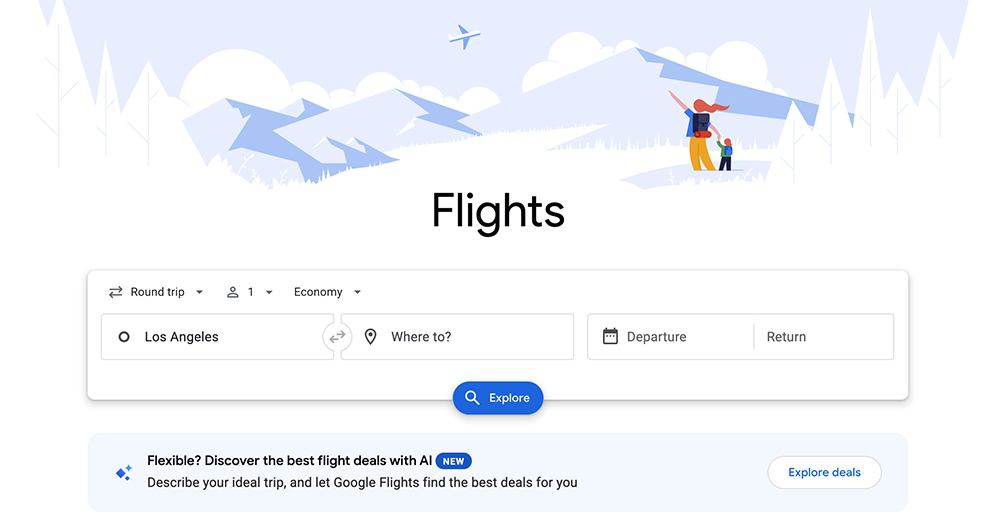Table of Contents
Hunting for affordable flights has always been part research project, part waiting game. Travelers scroll through dozens of search results, apply filters, and hope to spot a fare that fits both their budget and schedule. But what if the process could feel more like a conversation with a travel-savvy friend than a spreadsheet exercise?
That’s the promise behind Google’s new Flight Deals AI, an experimental feature within Google Flights that uses artificial intelligence to help travelers discover cheaper airfare in a smarter, more intuitive way. Instead of sifting through endless filters and date pickers, you can describe the trip you have in mind, and the AI does the heavy lifting, relieving you from the stress of traditional flight planning.
Let’s explore how this new tool works, what makes a “deal,” its limitations, and why it could change the way we plan our travels.
How It Works: Conversational Flight Search
The traditional Google Flights interface requires specific inputs, including departure and destination cities, travel dates, and filters such as nonstop flights or preferred airlines. While this works well for travelers with a set plan, it doesn’t help much if you’re just “looking for a good deal somewhere warm in January.”
That’s where Flight Deals AI comes in. The feature allows users to type in requests in natural language, just as they would when speaking to a friend or travel agent.
Some examples:
- “A week-long trip this winter to a city with great food, nonstop only.”
- “A 10-day ski trip to a world-class resort with fresh powder.”
- “A three-night beach vacation in September under $600.”
The AI interprets these conversational prompts, translates them into search parameters, and queries Google Flights’ extensive database of fares. It doesn’t just return obvious options; it can also suggest destinations you might not have considered, but that still fit your style, timing, and budget.
This natural language approach makes trip planning feel less like filling out a form and more like daydreaming out loud.
What Counts as a “Deal”?
Finding cheap airfare isn’t just about spotting a low number. A $400 ticket to Europe might look great, but if the typical price for that route is closer to $350, it’s not a genuine bargain.
Google’s Flight Deals AI defines a “deal” as a price that is significantly lower than the typical fare for a similar trip. To figure that out, the system analyzes:
- The median of the lowest fares over the past 12 months
- The seasonality of travel (holidays vs. off-season)
- Trip length and cabin class
Results are ranked primarily by percentage savings. A flight discounted 40% compared to its usual price will appear higher than one discounted 20%. If two flights have the same percentage savings, the flight with the lower overall price will take priority.
This ranking helps travelers quickly identify which flights offer actual value, rather than cluttering the results with every discounted fare.
Who Benefits Most?
Flight Deals AI is designed with flexible travelers in mind —people who are open to various destinations, dates, or both —and primarily seek the best deal.
- Great fit: Travelers who say, “I want a cheap beach trip in early fall” or “I just want to go skiing somewhere nice this winter.”
- Less ideal: Travelers who say, “I need to fly from Chicago to Denver on June 15 to attend a wedding.” For these cases, the traditional Google Flights interface remains the most effective option.
In short: the looser your criteria, the more likely Flight Deals AI will surprise you with options you hadn’t thought about.
Current Limitations
Since this is still a beta feature, Google is transparent that it doesn’t cover every scenario. At launch, the AI does not support:
- Multi-city trips
- Multiple departure cities
- Dates far in the future
- Large groups (more than four passengers)
- Layover preferences
So if you’re planning a multi-stop journey across Europe or need a flight for a family of six, you’ll still need to rely on the traditional Google Flights tools.
Availability and Future Outlook
As of its early rollout, Flight Deals AI is available to signed-in users in the U.S., Canada, and India. Google is actively collecting feedback and plans to expand the feature as it matures.
The company has emphasized that this AI tool is not intended to replace the classic Google Flights interface, but rather to complement it. Traditional inputs will remain the go-to method for rigid itineraries, while conversational search will cater to travelers seeking inspiration and savings.
Looking ahead, it’s easy to imagine Google layering more features onto this AI tool — from integrating hotel and package deals to supporting multi-city adventures. As AI becomes more deeply embedded in Google’s ecosystem, Flight Deals AI may evolve into a full-fledged travel assistant, catering to your unique needs and helping you move seamlessly from dreaming about a trip to booking it.
Why It Matters for Travelers
This experiment highlights a larger shift: AI is making travel planning more intuitive. Instead of wrestling with filters and guessing dates, users can dream aloud and let the system fill in the blanks.
For budget-conscious travelers, that means less time spent digging for hidden deals. For casual explorers, it means discovering destinations they might not have otherwise searched for.
While it won’t solve every problem yet, Flight Deals AI shows where the future of travel search is headed: less friction, more personalization, and better deals.
Final Thoughts on Flight Deals AI
Finding cheap flights has always been part skill, part luck. With Google’s Flight Deals AI, the balance is shifting toward a more innovative, AI-driven approach that understands travelers’ needs in plain language and delivers value-driven options.
If you’re flexible and adventurous, this tool could make your next getaway both easier to plan and kinder on your wallet.
Related Internal Links
- Budget-Friendly Travel Hacks
- Top Tips for Stress-Free Packing
- Why Walking is the Most Underrated Exercise






